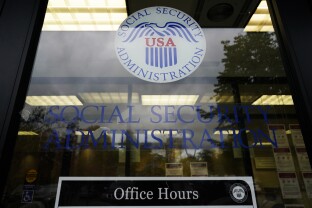The Social Security Administration is due this month to calculate how much to raise benefits for next year based on inflation. But the data it needs to run the numbers is stuck in another federal office emptied during the shutdown.
The Department of Labor furloughed more than 2,000 workers at the Bureau of Labor Statistics, according to the department’s shutdown contingency plan. That leaves just one employee working less than two weeks before the BLS is scheduled to release the September Consumer Price Index data, which measures average cost-of-living changes.
If the shutdown continues and more workers aren’t brought back within a month, the Social Security Administration’s work of calculating the percentage adjustment and notifying recipients of their benefit increases could be delayed, former senior officials and social insurance advocates told NOTUS.
“Recipients wait with bated breath for that number,” former Social Security Administration Commissioner Martin O’Malley said. “But the people who would calculate that at the Bureau of Labor Statistics aren’t coming to work in the shutdown. And this is when all of that stuff is supposed to get done so that the COLA will kick in.”
The furloughs have paused the work at a critical handoff point. The most recent period for the BLS to collect data on the prices of groceries, energy and household items ended on Sept. 30. In a typical year, the BLS would average out the data into the Consumer Price Index for Urban Wage Earners and Clerical Workers and publish it by mid-October. It is scheduled for release on Oct. 15 this year.
While most recipients likely don’t keep tabs on the Consumer Price Index numbers, they certainly expect their annual bump.
“You don’t think about it until you’re forced to think about it,” said Gbenga Ajilore, chief economist at the Center on Budget and Policy Priorities. “If the week of the 13th goes and there’s nothing about COLA, everyone’s going to pay attention to that.”
The Social Security Administration uses the consumer price index of the third quarter of the current year — July, August and September — and compares it to the same period of the prior year to set the annual Cost of Living Adjustment. Social Security recipients see the increase in their checks starting in January. In 2025, the agency increased benefits for nearly 73 million Americans by 2.5%.
The BLS did not release the Consumer Price Index before the shutdown, as employees are typically working on it at the beginning of October. The BLS did not respond to a request for comment on the status of the index.
For now, the Social Security Administration can run close estimates without the final September price index. But calculating benefit changes is not as easy as copying and pasting the BLS’s numbers, former leaders of the Social Security Administration said.
Economists spend the months from April — when they receive earnings data from the IRS — to October testing their software with estimated COLA figures to get an idea of what benefit increases will look like. Once they get the final Consumer Price Index from the BLS, they calculate the COLA and run the numbers for every single Social Security recipient before notices of benefits adjustments go out around Thanksgiving.
One source who previously served in a leadership role at the Social Security Administration said the work has to get done about four weeks before Thanksgiving, or the agency runs the risk of the notices going out late.
If the agency is back in business by the end of this month, employees will have several weeks to calculate new benefit amounts and notify recipients by the typical date.
In any case, the nail-biting could be avoided. The Social Security Administration is required by law to apply a COLA each year, which makes employees who calculate the adjustment essential workers during a government shutdown, according to a former senior official and advocates. Yet their hands may be tied unless the BLS deems the employees who work on the price index essential, too.
Social insurance advocates also expressed concern that the shutdown would delay or complicate payments to the 322,000 Social Security recipients who receive paper checks. In March, President Donald Trump issued an executive order mandating the transition to electronic payments for all federal disbursements by Sept. 30. The Social Security Administration urged recipients to enroll in direct deposit or sign up for a direct express card before then, but that will not jeopardize their payments during the shutdown, according to a spokesperson for the agency.
“Where a beneficiary has no other means to receive payment, we will continue to issue paper checks,” the spokesperson said in an email to NOTUS.
This site is protected by reCAPTCHA, and the Google Privacy Policy and Terms of Service apply. By continuing on NOTUS, you agree to its Terms of Use and Privacy Policy.
Sign in
Log into your free account with your email. Don’t have one?
This site is protected by reCAPTCHA, and the Google Privacy Policy and Terms of Service apply. By continuing on NOTUS, you agree to its Terms of Use and Privacy Policy.
Check your email for a one-time code.
We sent a 4-digit code to . Enter the pin to confirm your account.
New code will be available in 1:00
Let’s try this again.
We encountered an error with the passcode sent to . Please reenter your email.
This site is protected by reCAPTCHA, and the Google Privacy Policy and Terms of Service apply. By continuing on NOTUS, you agree to its Terms of Use and Privacy Policy.


